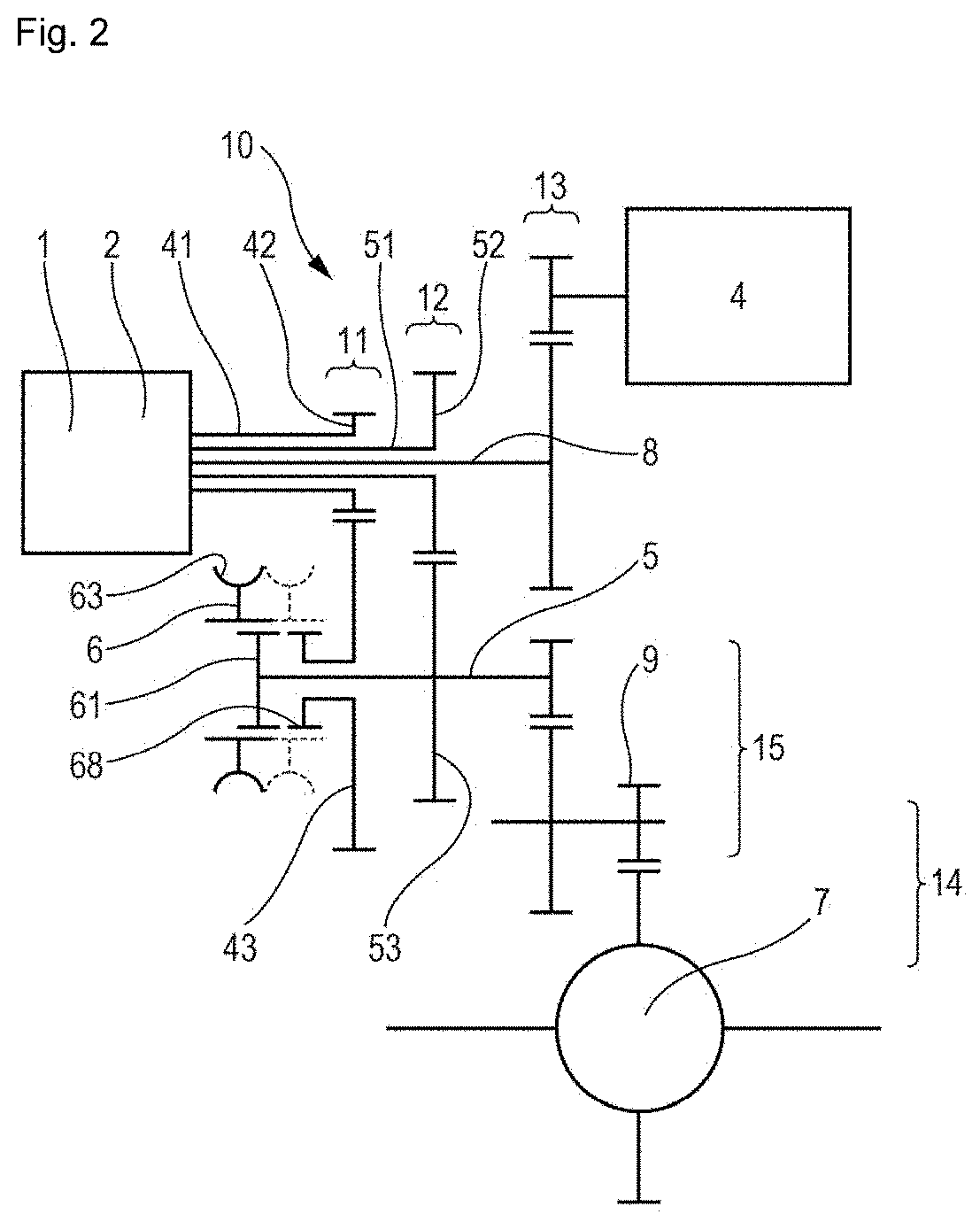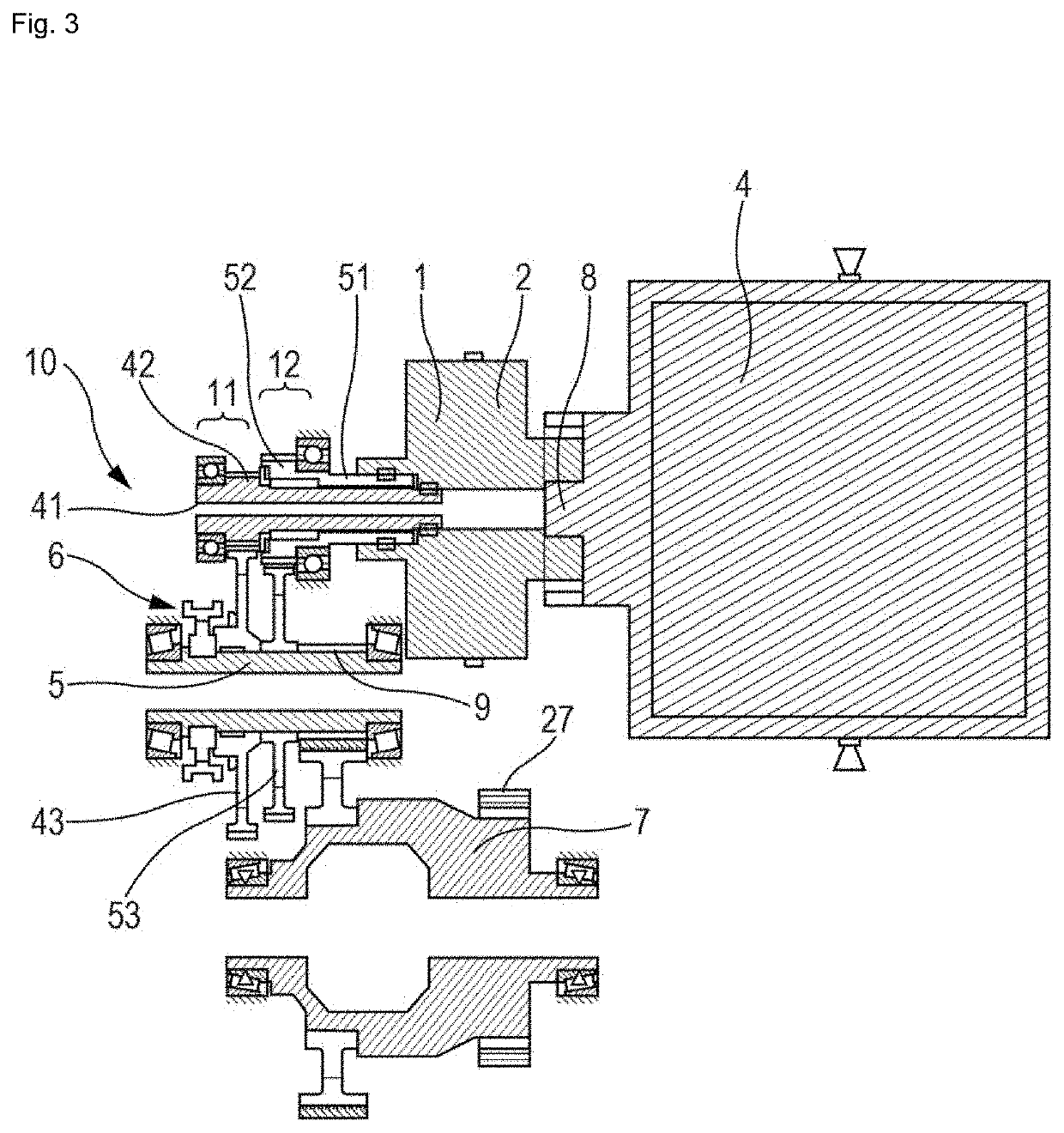Torque transmission device for a motor vehicle
a transmission device and motor vehicle technology, applied in mechanical equipment, transportation and packaging, gearboxes, etc., can solve the problems of unsatisfactory devices in terms of efficiency, excessive size and weight, and particularly harmful drag torque, so as to reduce or even eliminate the drag torque in the first clutch, avoid excessive spinning, and improve energy efficiency
- Summary
- Abstract
- Description
- Claims
- Application Information
AI Technical Summary
Benefits of technology
Problems solved by technology
Method used
Image
Examples
first embodiment
[0143]FIG. 1 is a block diagram illustrating the invention. FIG. 1 illustrates a torque transmission system comprising an electric motor 4 of a vehicle capable of propelling the vehicle, and a torque transmission assembly.
[0144]The torque transmission assembly includes a transmission device 10 and a differential 7 capable of driving two laterally opposite wheels of the vehicle. The torque transmission device 10 comprises an output member 9 coupled to the differential 7.
[0145]The torque transmission device 10 includes:[0146]a first clutch 1 comprising a first input element capable of being driven by the motor 4, and a first output element, torque being transmitted between the first input element and the first output element when the first clutch is closed,[0147]a second clutch 2 comprising a second input element capable of being driven by the motor, and a second output element, torque being transmitted between the second input element and the second output element when the second clu...
second embodiment
[0181]In the second embodiment shown schematically in FIG. 2, there is a first common reduction gear 13 arranged kinematically between the motor 4 and the dual clutch 1, 2. This common reduction gear is formed by a gear train. A second two-stage common reduction gear 15, 14 is also formed by a gear train between the transmission member 5 and the differential 7.
third embodiment
[0182]In the third embodiment shown in FIG. 4, there is a two-stage common reduction gear 15, 14 also formed by a gear train between the transmission member 5 and the differential 7.
[0183]In addition to these differences, the second embodiment in FIG. 2 is distinguished in that the first transmission mechanism 11 and the second transmission mechanism 12 are situated between the motor 4 and the first and second clutches 1, 2. In addition, the second input shaft 51 is a hollow shaft and the common torque input shaft 8 extends inside the hollow shaft 51.The three shafts 8, 51 and 41 are thus arranged inside each other, the common input shaft 8 extending inside the second input shaft 51, which extends inside the first input shaft 41. The footprint is thus limited.
[0184]In the first embodiment shown schematically in FIG. 3 and in the third embodiment shown in FIG. 4, the torque transmission assembly further comprises a parking brake mechanism including a toothed locking wheel 27 mounted ...
PUM
 Login to View More
Login to View More Abstract
Description
Claims
Application Information
 Login to View More
Login to View More - R&D
- Intellectual Property
- Life Sciences
- Materials
- Tech Scout
- Unparalleled Data Quality
- Higher Quality Content
- 60% Fewer Hallucinations
Browse by: Latest US Patents, China's latest patents, Technical Efficacy Thesaurus, Application Domain, Technology Topic, Popular Technical Reports.
© 2025 PatSnap. All rights reserved.Legal|Privacy policy|Modern Slavery Act Transparency Statement|Sitemap|About US| Contact US: help@patsnap.com



